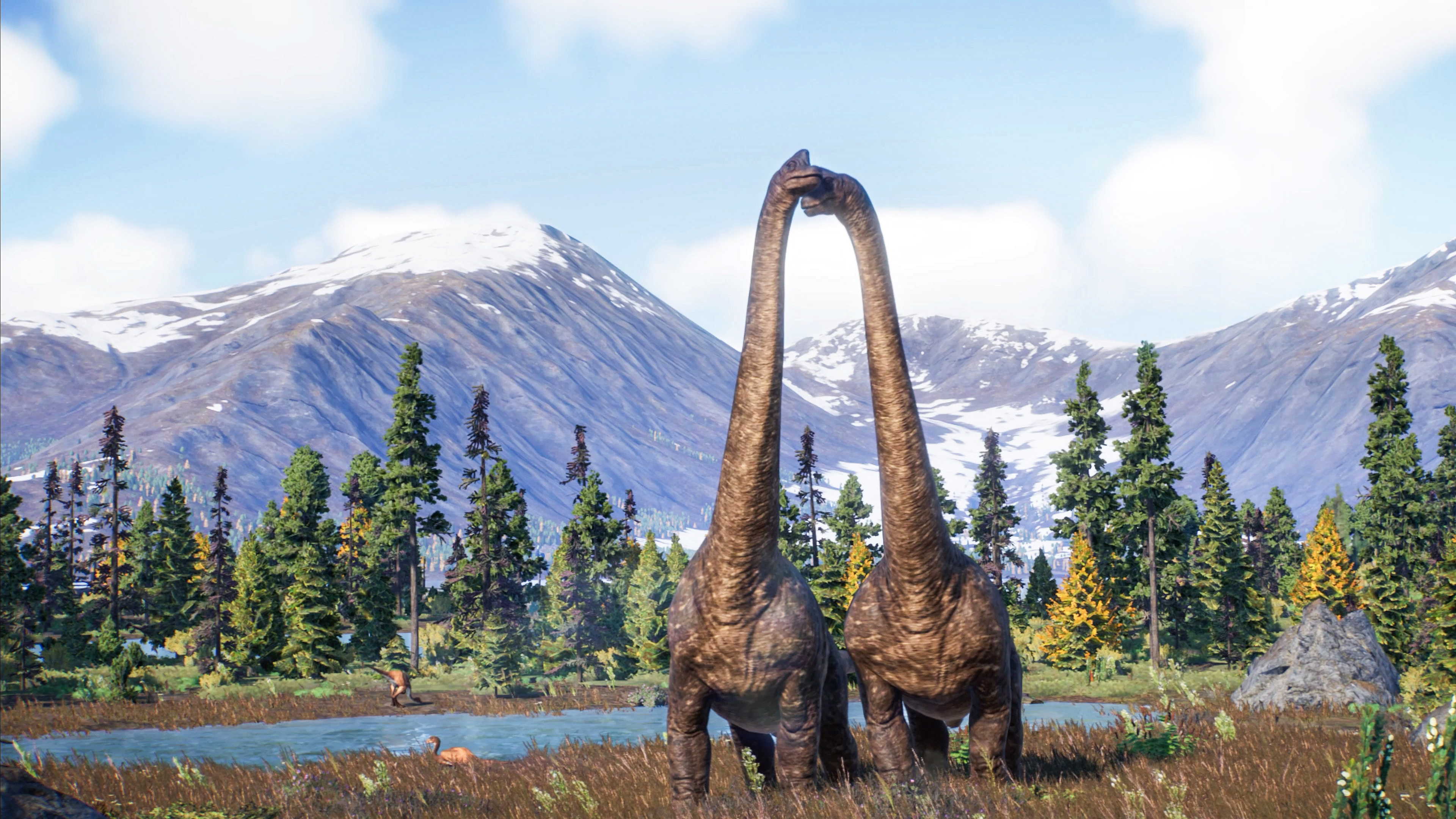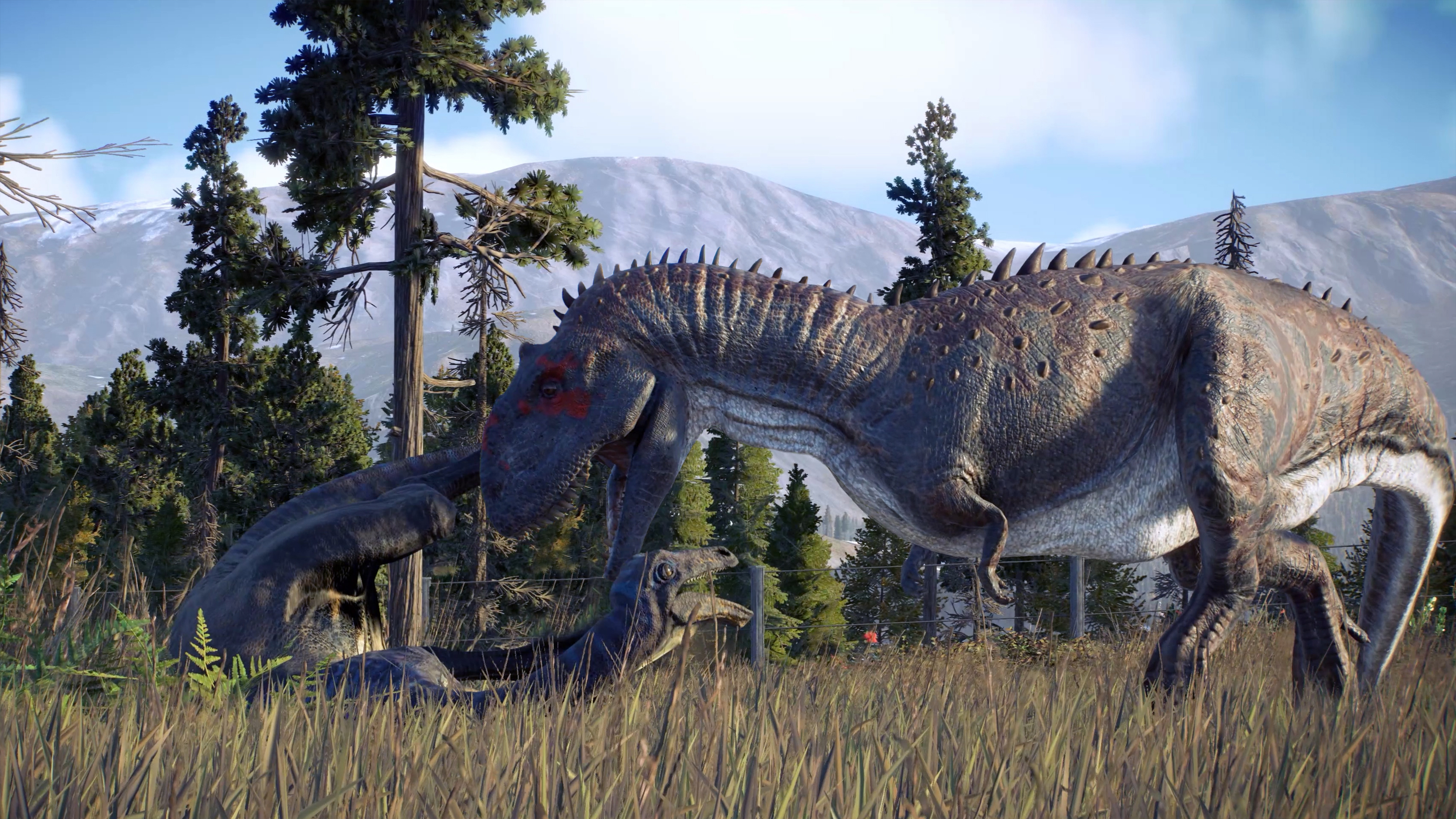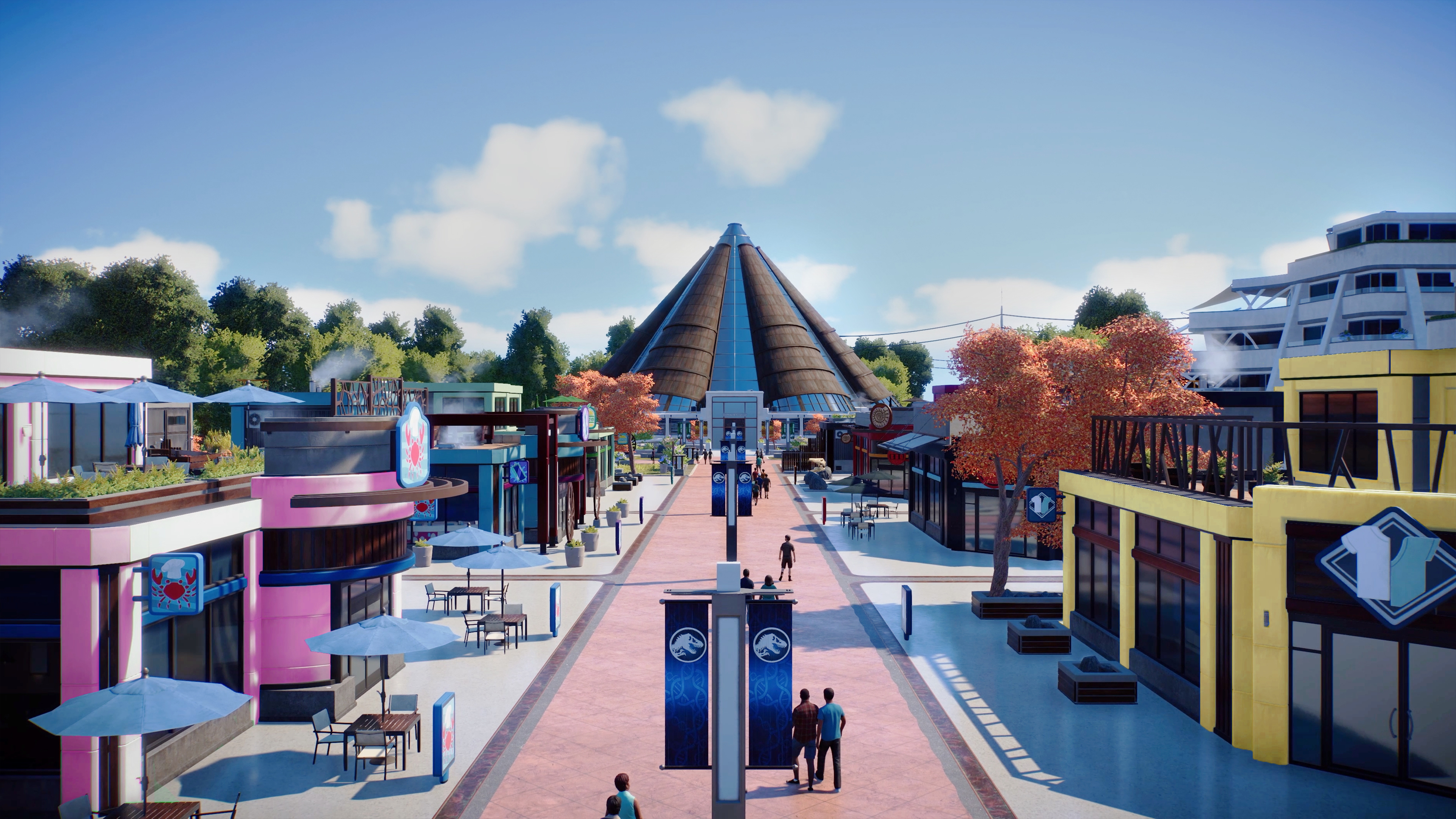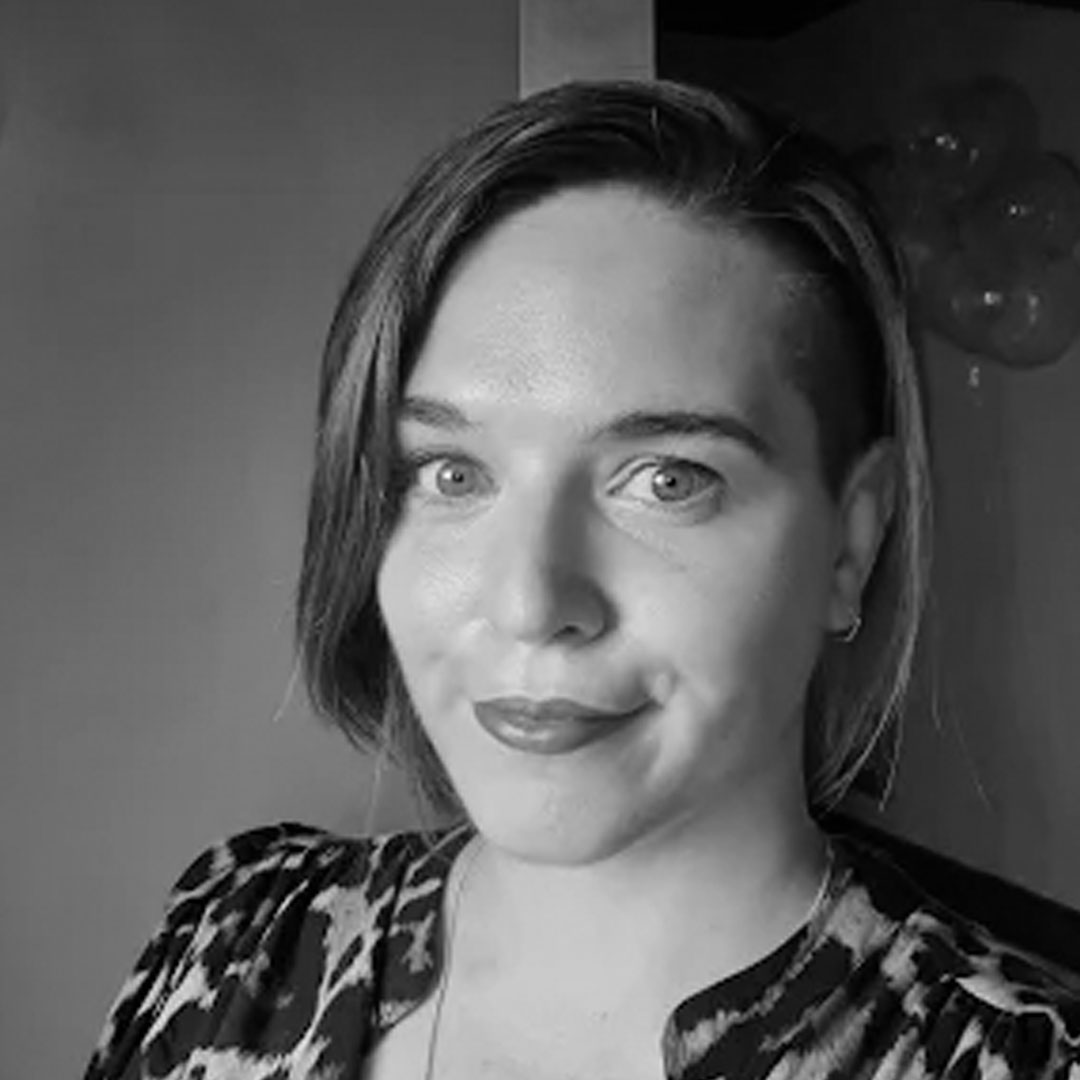Jurassic World Evolution 2 is about disasters as much as it is the dinosaurs
"Humanity will never not think they can manage dinosaurs", says dev Frontier
Jurassic World Evolution 2 is "not just a dinosaur management game," game director Rich Newbold explains, "It's a disaster management game." After going hands-on with Jurassic World Evolution 2, I've come to realize that it's a very important distinction. With this upcoming sequel, there is more potential for disaster than ever before – and not just from the dinosaurs themselves.
"Managing dinosaurs shouldn't be stress-free," laughs Newbold. "It's meant to be [stressful]! That's the whole point of Jurassic Park and Jurassic World. People thought they could deal with this problem, but they can't, so things are going to go wrong. And it's something we genuinely wanted to get across in Jurassic World Evolution 2."
And he's right, there's so much that can and will go wrong in Jurassic World Evolution 2 – so much so that my two hours with a pre-release build felt like a long series of crises. We start out with a slice from Jurassic World Evolution 2's campaign, which is set after the events of Jurassic World: Fallen Kingdom, so a big part of the story will be dealing with dinosaurs living truly in the wild. I'm able to play the second mission, which sees the aftermath of some poachers trying to capture a pair of Carnotaurus. Tiny enclosures and very angry carnivorous dinosaurs never really mix, so the poachers are, umm, long gone and the dinos less than happy about their current situation.

But, with new enclosures made and delicious goats supplied, I'm able to enjoy a few moments of harmonious existence before it's flagged that there's another carnivore on the loose. But instead of just scrolling around the map until it pops up on the radar, a hunt ensues. You'll need to get into your Ranger truck and physically hunt down the dino, discovering various disturbances like poop, broken trees, or dinner remains. The more traces you find, the closer you are to not only finding the dino but also identifying it. Once you find it, you'll have to bring in your helicopter team to tranquilize it, and then your transport team to bring it back to your park where you can start to look after it. The whole spectacle added a nice surprise little narrative moment to the management loop that works really well at making you feel like you're a real part of the running of things – rather than some strange overseer.
"We wanted to give players an opportunity to be really close up in person with dinosaurs. It's a different way of seeing dinosaurs as opposed to them sedately coming out of a hatchery or being delivered," explains Newbold. "We wanted to find ways to give players different moments and different experiences that layer on top of the facility or theme park management that they'll be doing."
Disaster strikes

However, as exciting as this little encounter was, it also highlighted that some of the quirks from the first game remain. The Ranger trucks still handle incredibly badly, drifting around and getting stuck on the terrain at regular intervals – even when you're physically behind the wheel. It's worrying because there's so much more focus on the Rangers with Jurassic World Evolution 2, with it introducing Ranger Posts that you'll need to add to every enclosure. These posts allow you to create patrol routes for your Rangers, where they'll drive through each dino pen they're assigned to in order to feedback crucial information about your dinosaurs. Well, they won't actually alert you if anything's wrong, but will instead allow you to see that information if you select each dinosaur. Get your timing wrong and a fog of war effect will shroud all that information, making it very hard for you to diagnose any grumpiness or discontent.
"It's all about managing your team so that they're going out at a periodic rate that's the right balance to give you that information before it vanishes," explains Newbold. "Because if something does go wrong, if your equilibrium is adjusted in any way – there's a storm coming in, or a disease does happen – you need that information so that you know how to deal with it."
Weekly digests, tales from the communities you love, and more

That will include a shift in a dinosaur's territory too. As part of the push for more realism in this sequel, Jurassic World Evolution 2 now sees dinosaurs map out their territory from the minute they're released from the Hammond Creative Lab. They'll be looking for the things they need to survive at all times, from other dinos of the same species, water, specific terrain, and food sources. For the meat-eaters, that's as easy as placing a pile of meat or a goat spawner, but for the herbivores, it requires using the terrain tools to add particular types of shrubs or trees. Once they've found everything they need they'll stick with that territory unless something causes them to shift slightly – whether that's other species being added to the enclosure or even more dinos of the same species added to a group.
"You might have a herd of, say, two Triceratopses, and they're going to need a certain amount of territory. But as you add more Triceratops to that herd, that territory requirement gets bigger and bigger, because that herd is bigger. And each territory each dinosaur needs individually gets bigger as the herd gets bigger, so it compounds," says Newbold. This is where the reliance on your rangers – and the new mobile vet unit by association – really comes into play. But that's also just one small part of the management systems featured in Jurassic World Evolution 2.
Life finds a way… to overwhelm you

Leaping from the campaign mode and straight into a Challenge map, where you're basically on your own to build a successful park, the amount of new systems in the game is frankly almost suffocating. Beyond the dinosaurs, you'll also have far more involvement in the happiness of your guests, with the ability to have more control over the amenities and facilities in your park and then tailor them to appeal to certain kinds of visitors. There are four interest groups now, with you able to designate certain areas of your park to satisfy more specific requirements – like nature-lovers wanting to see more herbivores, for example.
You now have staff too, who'll you need to manage and assign jobs. Each scientist comes with its own proficiencies spread across genetics, welfare, and construction, which equates to a value that you'll need to assign to do various different tasks, whether that's incubating and hatching dinosaur eggs, researching new species, excavating fossils, or unlocking the lagoons or aviaries for the new flying and aquatic reptiles. Use them too much though and they'll have to take a break in the staff room – which is weirdly another expense on top of their salary – otherwise they'll start sabotaging your park. It feels more authentic in terms of the process of creation, but piecing together how it all works, and the extra steps involved compared to the last game will take some getting used to.

"Scientists are part of every stage of dinosaur reaction, and then also the research system," says Newbold. "So sending out expeditions, extracting fossils, incubating a dinosaur, medicating and healing dinosaurs, will all need different [scientist] proficiencies, and then also research. It allowed us to create that kind of a puzzle element."
It's definitely a more complicated loop to get access to everything you'll need to keep staff, guests, and dinosaurs happy. And more expensive too, meaning more micro-level decision-making than ever before. There are major improvements to some elements too though, like being able to release multiple dinosaurs at once, rather than doing it one at a time and praying you could release them fast enough to nip loneliness in the bud before chaos ensued. You can also hatch dinosaurs by airlifting them into another enclosure, cutting down on building duplication. The dinosaurs themselves have more unique personalities and interact with each other more too. Plus the power supply system is much simpler, although making sure your vehicles, substations, and other power-suckers have enough fuel is another thing to manage.

There are so many ways that disaster can strike in Jurassic World Evolution 2 that I'm worried it's fallen foul of its own ambition. Something the original game struggled with was the onboarding process, with tutorials few and far between. Newbold assures me that the campaign is basically "a really long tutorial for a lot of different things", but I still have my doubts that there's enough of a feedback loop between the player and the game. The UI is rarely intuitive, and a lot has changed between this iteration and the first game, and I'm not always sure it's for the better. Even just simple things like my guests demanding 'Entertainment', but the UI never really being clear on what that constitutes of. As someone who has spent hundreds of hours learning and thoroughly enjoying the first game, the new systems still feel baffling.
But, then again maybe that's part of the design. "We wanted you to have those moments where you have to make a conscious choice as to which one you think is best for you. But there's going to be a consequence for that action as well… Humanity will never not think they can manage dinosaurs," laughs Newbold. And maybe Jurassic World Evolution 2 is going to prove him – and Ian Malcom – right.
Jurassic World Evolution 2 is launching November 9, 2021 on PC, PS5, Xbox Series X, Xbox One, and PS4. For now, check out all the new games confirmed for 2021 and beyond.

Sam Loveridge is the Brand Director and former Global Editor-in-Chief of GamesRadar. She joined the team in August 2017. Sam came to GamesRadar after working at TrustedReviews, Digital Spy, and Fandom, following the completion of an MA in Journalism. In her time, she's also had appearances on The Guardian, BBC, and more. Her experience has seen her cover console and PC games, along with gaming hardware, for a decade, and for GamesRadar, she's in charge of the site's overall direction, managing the team, and making sure it's the best it can be. Her gaming passions lie with weird simulation games, big open-world RPGs, and beautifully crafted indies. She plays across all platforms, and specializes in titles like Pokemon, Assassin's Creed, The Sims, and more. Basically, she loves all games that aren't sports or fighting titles! In her spare time, Sam likes to live like Stardew Valley by cooking and baking, growing vegetables, and enjoying life in the countryside.


